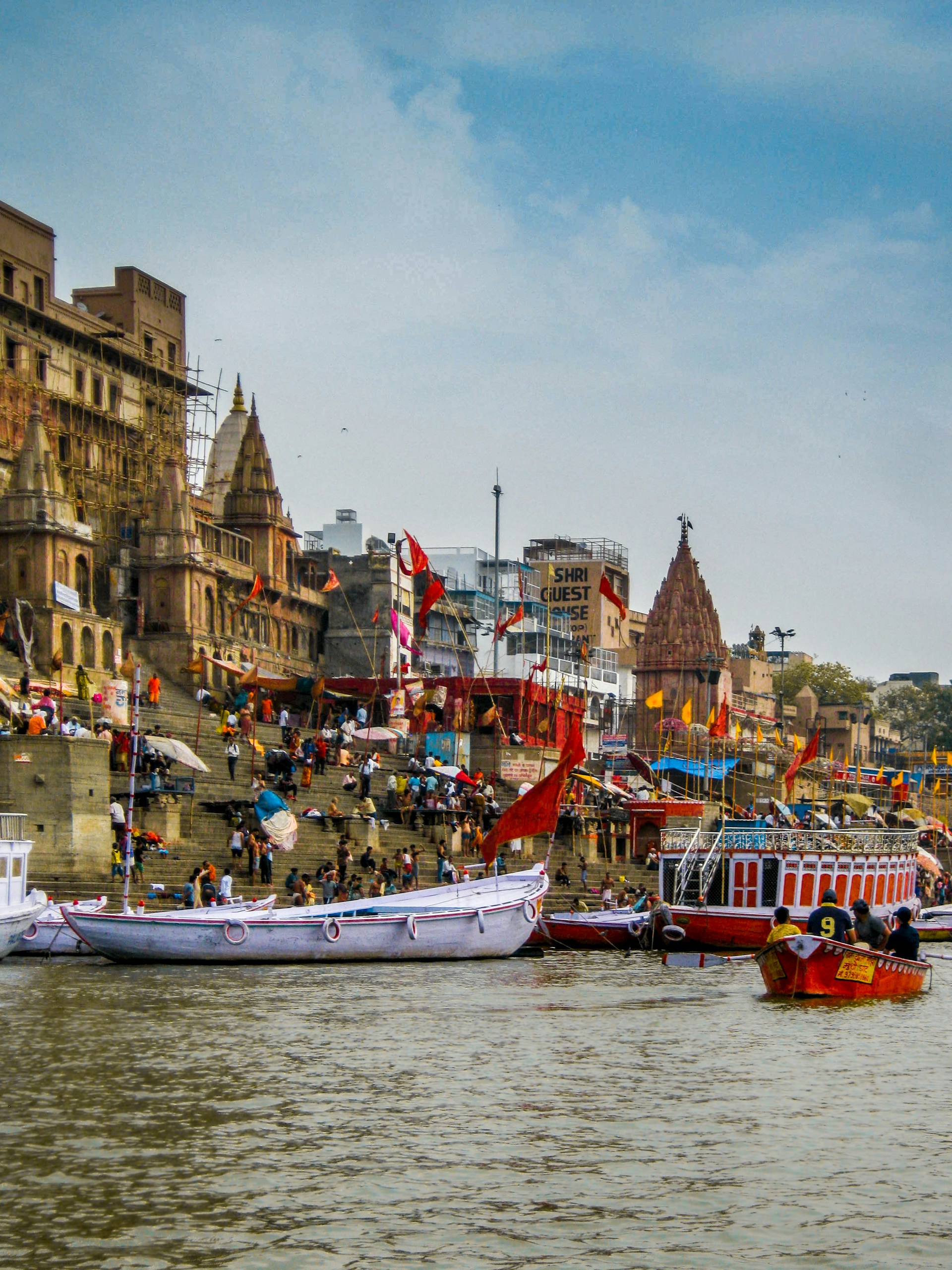
Varanasi, also known as Kashi or Banaras, is one of the oldest cities in the world and a spiritual and cultural epicenter of Hinduism. Nestled on the banks of the sacred Ganges River in the northern state of Uttar Pradesh, India, Varanasi has been a focal point for pilgrimage for millennia. This city is not just a destination; it is a sanctified journey that transcends the ordinary, offering a profound experience for those who seek the divine.
Cover photo by Srivatsan Balaji
The Hallowed Ganga
The Ganges River, or Ganga as it is reverently called, is considered the holiest river in India. It is believed that bathing in its waters can wash away sins and lead to salvation. The river’s sacredness is a central theme in Hindu mythology and has been a source of spiritual sustenance for countless generations. The ghats, or stone steps, leading down to the Ganges are where the devout come to perform rituals, offer prayers, and bathe with a faith that is deeply rooted in tradition.
The Ghats: A Tapestry of Rituals and Life
Varanasi boasts an intricate network of ghats, each with its unique character and purpose. The most famous among them are the Dashashwamedh Ghat, where the Ganga Aarti takes place every evening, and the Manikarnika and Harishchandra ghats, where cremations are performed day and night. These ghats are not just stone staircases but are living entities that pulse with the rhythm of life, death, and rebirth.
The Dashashwamedh Ghat is a hive of activity, with priests performing rituals for the faithful, who come to offer prayers or to take a dip in the river. The Aarti ceremony here is a mesmerizing spectacle, where lamps are offered to the Goddess Ganga, accompanied by chants and devotional music. It is a moment of communion between the divine and the mortal, encapsulating the essence of Varanasi’s spiritual journey.
The Aarti: An Enchanting Ritual
The Aarti at the Dashashwamedh Ghat is not merely a religious ritual; it is an enactment of devotion that transcends the mundane. As the priest waves the lamps, their flames flicker against the backdrop of the setting sun, casting a divine glow on the gathered crowd. The air fills with incense and the sound of bells and drums, creating an atmosphere of otherworldly beauty and serenity. For the pilgrim, it is a moment of profound connection with the divine, a highlight of their sacred journey.
The Sacred Rituals: A Symphony of Devotion
Beyond the Aarti, Varanasi’s ghats are stages for a symphony of devotional rituals that occur throughout the day and night. Each ritual has its significance and is performed with meticulous care by priests who have inherited this sacred duty through generations. From the somber rites at Manikarnika Ghat, where the deceased are cremated in a ceremony that honors the transition from one life to another, to the joyous weddings and naming ceremonies, the ghats bear witness to all aspects of life.
The Philosopher’s Haven: The Vedantic Tradition
Varanasi is also renowned as a center for learning and philosophy. The city has been home to many sages and philosophers who have contributed significantly to Hindu thought, particularly the Advaita Vedanta tradition. This school of Hindu philosophy, which emphasizes the non-dualistic understanding of the relationship between the Atman (soul) and Brahman (ultimate reality), has its roots here. The city’s many ashrams and temples offer a sanctuary for seekers to meditate, study, and engage in deep introspection, making Varanasi a haven for philosophers and contemplatives alike.
The Architectural Marvels: Temples and Tombs
Varanasi is also a treasure trove of architecture that reflects the city’s rich history and cultural significance. The Kashi Vishwanath Temple, dedicated to one of Hinduism’s most revered deities, Shiva, is a marvel of marble and gold that draws pilgrims from all over the world. The temple’s intricate carvings and serene atmosphere are a testament to the city’s artistic heritage.
Another architectural marvel is the Bharat Mata Temple, unique in its representation of India as the mother goddess. The temple is adorned with marble reliefs depicting key moments from India’s history, celebrating the country’s diverse cultures and traditions.
The Artisans: Keepers of Tradition
Varanasi is also a hub for traditional Indian crafts. Silk weaving, pottery, and handloom weaving are among the city’s time-honored crafts, kept alive by generations of artisans who have mastered these skills. A pilgrimage to Varanasi is incomplete without exploring these crafts, understanding their significance, and appreciating the skill and dedication of the artisans who continue to uphold this rich cultural legacy.
The Cuisine: A Feast for the Soul
No visit to Varanasi is complete without experiencing its culinary delights. The city’s cuisine is a reflection of its diverse culture and is characterized by simple, wholesome dishes that are as nourishing for the body as they are for the soul. From the iconic kachori-sabzi breakfast to the sweetness of peda, each dish carries with it the essence of Varanasi’s cultural tapestry.
The Pilgrimage Experience: Beyond the Ordinary
Embarking on a pilgrimage to Varanasi is an immersive experience that transcends the act of visiting a place of religious significance. It is a journey that stirs the soul, challenges preconceived notions, and opens one’s heart to the profound mysteries of life, death, and the existence beyond. For many, it is a transformative experience that leaves an indelible mark on their spiritual journey.
The Transformative Power: A Journey Within
The pilgrimage to Varanasi is as much about the outer journey—walking the ghats, visiting the temples, and engaging with the city’s myriad cultural experiences—as it is about the inner journey. It is a time for introspection, for shedding layers of the ego, and for connecting with the divine within oneself. The city’s spiritual energy is palpable, and many visitors report profound personal transformations as a result of their time spent in Varanasi.
The Enduring Legacy: A Living Tradition
Varanasi’s enduring legacy as a sacred city is a testament to its timeless appeal. It is a place where tradition and modernity coexist, where the river flows with the wisdom of antiquity, and where every stone, every ritual, every moment is imbued with the potential for spiritual awakening. For those who make the pilgrimage, Varanasi offers not just a fleeting visit but an experience that resonates with the eternal questions of existence, offering a glimpse into the profound mysteries that lie at the heart of the human condition.
Conclusion: A Pilgrimage for All Seasons
A pilgrimage to Varanasi is a journey unlike any other. It is a sacred odyssey that calls to the spirit, inviting each individual to explore the depths of their faith, their culture, and ultimately, themselves. Whether one comes seeking spiritual enlightenment, a deeper connection with tradition, or simply a moment of respite from the world’s relentless pace, Varanasi welcomes all with open arms.
As the sun sets over the Ganges, painting the sky with hues of orange and pink, the pilgrim stands on the ghats, a silent witness to the unfolding drama of life. In this moment, the past and the present merge, the mundane and the divine intertwine, and the pilgrim realizes that they have embarked upon a journey not only to Varanasi but to the very core of their being.
Varanasi is a living city, a sacred space where every stone tells a story, every ritual holds a secret, and every moment is an opportunity for transformation. It is a place that continues to draw people from around the world, a beacon of spiritual light in a world that often seems enshrouded in darkness.
For those who walk the ghats, who bathe in the holy waters, who watch the cremations and the offerings, Varanasi is not just a place to visit—it is a place to experience, to feel, to be transformed by. It is a journey that stays with one long after the footprints have faded into the sands of time.
In the end, a pilgrimage to Varanasi is a journey within, a reflection of one’s own soul’s quest for understanding, peace, and ultimately, a place where one can truly be oneself, unencumbered by the expectations of the world. It is a journey that transcends borders, beliefs, and time—a journey that is as vital today as it was thousands of years ago.
And so, the pilgrim departs, carrying with them not just memories of Varanasi but a piece of its soul, a touch of its timeless wisdom, and a newfound understanding of what it means to walk a sacred path.


